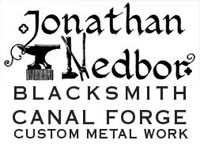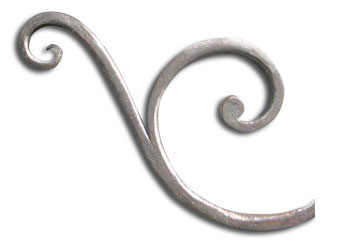


By careful consideration of the sense and feel for the historic object and of the working of the material itself, the end result will be the seamless integration of my reproduction ironwork with its historic counterparts in an historic setting.
The subtly of the feeling of historic work is often due to the immediacy of the work done at the anvil. The forged shapes can appear "casual" as they grew under the blows of the hammer. It was the smith's familiarity with the styles, designs and applications that would allow this freehand development of the shapes to look as though casually done.
This direct approach to shaping hot metal necessitates quick judgment and a good eye as well as a thorough knowledge of the process. Evidence of these skills can be seen even in primitive forge work as a quiet elegance.
For efficiency, a smith would strive to do as much of the shaping on the anvil as possible, working by eye with an economy of effort to form the hot metal. Many companion pieces do not match exactly, though they are similar enough to be a "pair."
In working iron to create a reproduction it is helpful to try to develop a sense of the historic smith in his time and place.
A few of the questions one can ask are:
What were the smith's motivations and approaches to the product at hand and how might that have influenced the form that the work took on?
Was this work routine or an occasional item made in the shop?
Was it following a prescribed pattern, was there room for creativity?
What was the design based on? Decorative ironwork was of course influenced by the allied arts of its time. How insular was the community, were there outside influences?
How strong were the ties to tradition or was there the urge to follow the latest styles. What tools and materials were available?
How well equipped would the shop have been and were the tools "new" or well worn? What was the availability of iron stock and in what shapes and sizes?
How much detailing and how would it have been applied? Was it done at the anvil with the hammer or other tools, or at the bench with files, saws and chisels?
A note on the use of Wrought Iron:
Wrought Iron, as opposed to steel, is the appropriate material for accurately reproducing the original hardware on an historic building.
Since Wrought Iron is no longer produced, the work on a piece of hardware often begins with the re-forging of old wrought iron stock to the size needed before starting the work on the hardware needed. For example, for an H hinge, I may start with a bar 1" square and forge it to 1/8" thick by 2 -1/2" wide to create the raw material for the hinge.
In addition, the fibrous structure of Wrought Iron requires a more careful working of the material to successfully produce each piece. There is a grain to Wrought Iron that can delaminate if worked carelessly. The material needs to be worked at welding heat often throughout the forging process to maintain the integrity of the iron.
There are several good reasons for the use of Wrought Iron on historic structures: it is the same material that was used in the period; the look of forged Iron replicates the look and feel of the original work; Wrought Iron is naturally more rust resistant than steel, so this work will last for hundreds of years.
For some hardware elements I recommend "Pure Iron," a modern material that was available for only a short time in the 1990's. It has the same chemical makeup as Wrought Iron but was a purified molten iron rolled from billets produced in a German steel mill. Because it has minimal grain, I recommend this material for some hardware parts such as nails, which often require clinching.